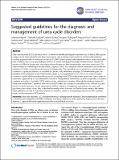Por favor, use este identificador para citar o enlazar a este item:
http://hdl.handle.net/10261/59504COMPARTIR / EXPORTAR:
 SHARE
BASE SHARE
BASE
|
|
| Visualizar otros formatos: MARC | Dublin Core | RDF | ORE | MODS | METS | DIDL | DATACITE | |

| Campo DC | Valor | Lengua/Idioma |
|---|---|---|
| dc.contributor.author | Häberle, Johannes | - |
| dc.contributor.author | Boddaert, Nathalie | - |
| dc.contributor.author | Burlina, Alberto | - |
| dc.contributor.author | Chakrapani, Anupam | - |
| dc.contributor.author | Dixon, Marjorie | - |
| dc.contributor.author | Huemer, Martina | - |
| dc.contributor.author | Karall, Daniela | - |
| dc.contributor.author | Martinelli, Diego | - |
| dc.contributor.author | Crespo, Pablo S. | - |
| dc.contributor.author | Santer, René | - |
| dc.contributor.author | Servais, Aude | - |
| dc.contributor.author | Valayannopoulos, Vassili | - |
| dc.contributor.author | Lindner, Martin | - |
| dc.contributor.author | Rubio, Vicente | - |
| dc.contributor.author | Dionisi-Vici, Carlo | - |
| dc.date.accessioned | 2012-11-06T06:11:11Z | - |
| dc.date.available | 2012-11-06T06:11:11Z | - |
| dc.date.issued | 2012-05-29 | - |
| dc.identifier | http://dx.doi.org/10.1186/1750-1172-7-32 | - |
| dc.identifier.citation | Orphanet Journal of Rare Diseases. 7(1):32 (2012) | - |
| dc.identifier.uri | http://hdl.handle.net/10261/59504 | - |
| dc.description.abstract | Abstract Urea cycle disorders (UCDs) are inborn errors of ammonia detoxification/arginine synthesis due to defects affecting the catalysts of the Krebs-Henseleit cycle (five core enzymes, one activating enzyme and one mitochondrial ornithine/citrulline antiporter) with an estimated incidence of 1:8.000. Patients present with hyperammonemia either shortly after birth (~50%) or, later at any age, leading to death or to severe neurological handicap in many survivors. Despite the existence of effective therapy with alternative pathway therapy and liver transplantation, outcomes remain poor. This may be related to underrecognition and delayed diagnosis due to the nonspecific clinical presentation and insufficient awareness of health care professionals because of disease rarity. These guidelines aim at providing a trans-European consensus to: guide practitioners, set standards of care and help awareness campaigns. To achieve these goals, the guidelines were developed using a Delphi methodology, by having professionals on UCDs across seven European countries to gather all the existing evidence, score it according to the SIGN evidence level system and draw a series of statements supported by an associated level of evidence. The guidelines were revised by external specialist consultants, unrelated authorities in the field of UCDs and practicing pediatricians in training. Although the evidence degree did hardly ever exceed level C (evidence from non-analytical studies like case reports and series), it was sufficient to guide practice on both acute and chronic presentations, address diagnosis, management, monitoring, outcomes, and psychosocial and ethical issues. Also, it identified knowledge voids that must be filled by future research. We believe these guidelines will help to: harmonise practice, set common standards and spread good practices with a positive impact on the outcomes of UCD patients. | - |
| dc.description.sponsorship | Development of these guidelines was financially supported by the “Guideline-Pool” from the German Metabolic Society (Arbeitsgemeinschaft für Pädiatrische Stoffwechselstörungen) who received funding from Cytonet, Merck Darmstadt, Merck Serono, Orphan Europe, SHS International. The second guideline group meeting was in addition supported by Nutricia Italia, Orphan Europe and Swedish Orphan International. The third GDG meeting received additional financial and logistic support from CIBERER, Spain. The authors confirm full independence from the aforementioned sponsors who did not influence the guidelines development at any stage. JH receives support for the scientific work on UCDs from the Swiss National Science Foundation (grant 310030_127184/1). VR received support from grants BFU2008-05021 of the Spanish Ministry of Science and Prometeo/2009/051 of the Valencian Government. CDV was supported by the grant “CCM 2010: Costruzione di percorsi diagnostico-assistenziali per le malattie oggetto di screening neonatale allargato” from the Italian Ministry of Health. The clinical fellowship of DM is supported by the “Associazione la Vita è un Dono”. Distribution of the guidelines is endorsed by the DGKJ (Deutsche Gesellschaft für Kinder- und Jugendmedizin) which offers support for translations. These guidelines have been adopted by and will be further developed under the umbrella of the “E-IMD” project which has received funding from the European Union, in the framework of the Health Programme. | - |
| dc.language.iso | eng | - |
| dc.publisher | BioMed Central | - |
| dc.relation.isversionof | Publisher's version | - |
| dc.rights | openAccess | - |
| dc.title | Suggested Guidelines for the Diagnosis and Management of Urea Cycle Disorders | - |
| dc.type | artículo | - |
| dc.date.updated | 2012-11-06T06:11:12Z | - |
| dc.description.version | Peer Reviewed | - |
| dc.rights.holder | Johannes Häberle et al.; licensee BioMed Central Ltd. | - |
| dc.type.coar | http://purl.org/coar/resource_type/c_6501 | es_ES |
| item.openairetype | artículo | - |
| item.grantfulltext | open | - |
| item.cerifentitytype | Publications | - |
| item.openairecristype | http://purl.org/coar/resource_type/c_18cf | - |
| item.fulltext | With Fulltext | - |
| item.languageiso639-1 | en | - |
| Aparece en las colecciones: | (IBV) Artículos | |
Ficheros en este ítem:
| Fichero | Descripción | Tamaño | Formato | |
|---|---|---|---|---|
| 1750-1172-7-32.xml | 310,17 kB | XML | Visualizar/Abrir | |
| 1750-1172-7-32.pdf | 899,43 kB | Adobe PDF |  Visualizar/Abrir |
CORE Recommender
Page view(s)
447
checked on 19-abr-2024
Download(s)
859
checked on 19-abr-2024
Google ScholarTM
Check
NOTA: Los ítems de Digital.CSIC están protegidos por copyright, con todos los derechos reservados, a menos que se indique lo contrario.
